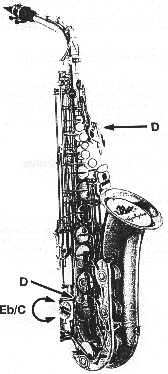| Now for the first time, you can play chords using a monophonic wind instrument. It is possible to add a second, third, or even a fourth additional
voice to accompany your melodic lines. The addition of extra voices is controlled by the command fingerings described below. The resulting
harmonic structures are not simply at fixed intervals but change to remain diatonic to a key area that you select (s.
4.2). In addition, inversions of
each structure may be played by varying the lip pressure against the reed.
By applying variable pressure on the reed while repeatedly playing the
same note, you are experiencing changes of inversions. Tight lip pressure produces a close position, while lighter lip pressure causes the
inversion to shift to more open voicings.
You may appreciate the musical potential of this control more easily if you begin with a two note
structure and work up toward the maximum of 5 voices. |
